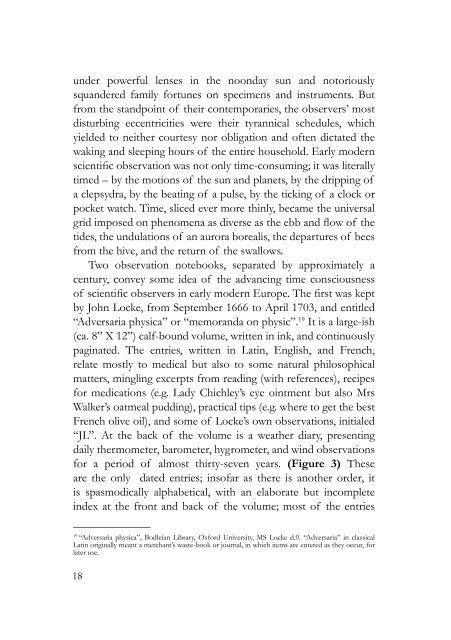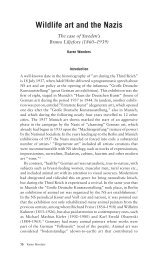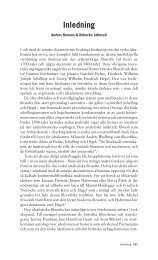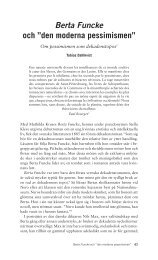Observation as a Way of Life: Time, Attention, Allegory
Observation as a Way of Life: Time, Attention, Allegory
Observation as a Way of Life: Time, Attention, Allegory
Create successful ePaper yourself
Turn your PDF publications into a flip-book with our unique Google optimized e-Paper software.
under powerful lenses in the noonday sun and notoriously<br />
squandered family fortunes on specimens and instruments. But<br />
from the standpoint <strong>of</strong> their contemporaries, the observers’ most<br />
disturbing eccentricities were their tyrannical schedules, which<br />
yielded to neither courtesy nor obligation and <strong>of</strong>ten dictated the<br />
waking and sleeping hours <strong>of</strong> the entire household. Early modern<br />
scientific observation w<strong>as</strong> not only time-consuming; it w<strong>as</strong> literally<br />
timed – by the motions <strong>of</strong> the sun and planets, by the dripping <strong>of</strong><br />
a clepsydra, by the beating <strong>of</strong> a pulse, by the ticking <strong>of</strong> a clock or<br />
pocket watch. <strong>Time</strong>, sliced ever more thinly, became the universal<br />
grid imposed on phenomena <strong>as</strong> diverse <strong>as</strong> the ebb and flow <strong>of</strong> the<br />
tides, the undulations <strong>of</strong> an aurora borealis, the departures <strong>of</strong> bees<br />
from the hive, and the return <strong>of</strong> the swallows.<br />
Two observation notebooks, separated by approximately a<br />
century, convey some idea <strong>of</strong> the advancing time consciousness<br />
<strong>of</strong> scientific observers in early modern Europe. The first w<strong>as</strong> kept<br />
by John Locke, from September 666 to April 70 , and entitled<br />
“Adversaria physica” or “memoranda on physic”. 9 It is a large-ish<br />
(ca. 8” X 2”) calf-bound volume, written in ink, and continuously<br />
paginated. The entries, written in Latin, English, and French,<br />
relate mostly to medical but also to some natural philosophical<br />
matters, mingling excerpts from reading (with references), recipes<br />
for medications (e.g. Lady Chichley’s eye ointment but also Mrs<br />
Walker’s oatmeal pudding), practical tips (e.g. where to get the best<br />
French olive oil), and some <strong>of</strong> Locke’s own observations, initialed<br />
“JL”. At the back <strong>of</strong> the volume is a weather diary, presenting<br />
daily thermometer, barometer, hygrometer, and wind observations<br />
for a period <strong>of</strong> almost thirty-seven years. (Figure 3) These<br />
are the only dated entries; ins<strong>of</strong>ar <strong>as</strong> there is another order, it<br />
is sp<strong>as</strong>modically alphabetical, with an elaborate but incomplete<br />
index at the front and back <strong>of</strong> the volume; most <strong>of</strong> the entries<br />
9 “Adversaria physica”, Bodleian Library, Oxford University, MS Locke d.9. “Adversaria” in cl<strong>as</strong>sical<br />
Latin originally meant a merchant’s w<strong>as</strong>te-book or journal, in which items are entered <strong>as</strong> they occur, for<br />
later use.<br />
8






